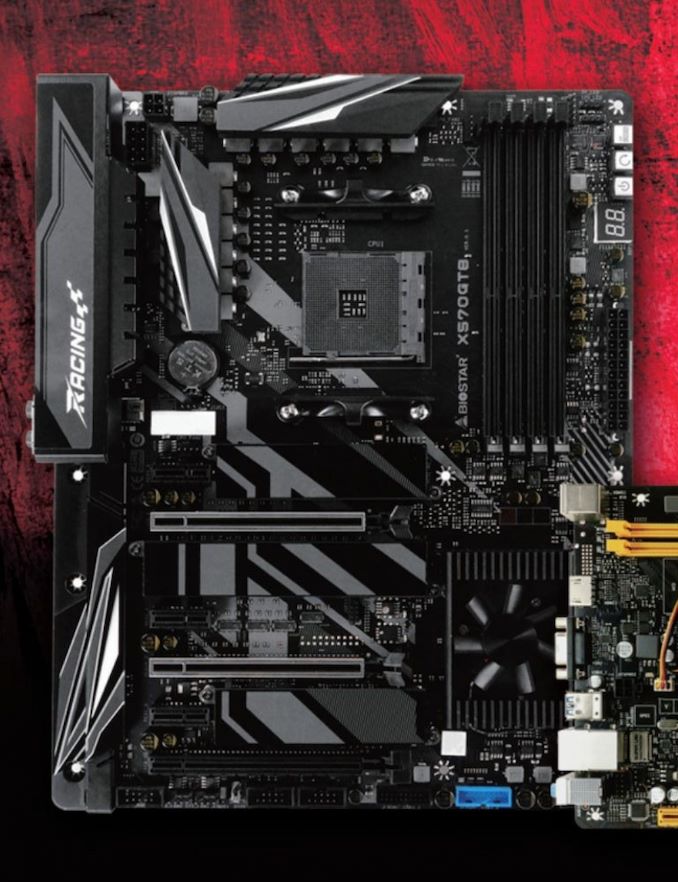The AMD X570 Motherboard Overview: Over 35+ Motherboards Analyzed
by Gavin Bonshor on July 9, 2019 8:00 AM ESTBiostar X570 Racing GT8
As it currently stands, the Biostar X570 Racing GT8 motherboard is the only model from its product stack at the launch of the X570 chipset. Upon speaking to Biostar at Computex, they did go on to say that they will release a mini-ITX model, most likely named the Racing X570GTN; we actually reviewed the previous Biostar X370GTN, and X470GTN AM4 mini-ITX motherboards. The Biostar X570 Racing GT8 has a black and grey PCB, with grey and silver heatsinks and is inspired by motor racing.
The Biostar X570 Racing GT8 ATX motherboard has three full-length PCIe 4.0 slots, with two fed by the CPU supporting x16, x8/x8, and x8/x8/x4 configurations. The bottom full-length slot is fed directly from the X570 chipset and is locked down at x4. There are also three PCIe 4.0 x1 slots available for use. On the black and grey contrasting PCB, with grey heatsinks, Biostar is using a 12-phase power delivery with an 8-pin and 4-pin pairing of 12 V ATX CPU power connectors. In the top-right hand corner of the board is four memory slots with support for up to DDR4-4000, (confirm capacity). On the storage front is three PCIe 4.0 x4 M.2 slots with six SATA ports capable of supporting RAID 0, 1, and 10 arrays.
On the rear panel are five 3.5 mm audio jacks and a S/PDIF optical output controlled by a Realtek ALC1220 8-channel HD audio codec, with the single Ethernet port which is controlled by an Intel I211-AT Gigabit NIC. For users looking to use AMD's Ryzen APUs, the rear panel also has a set of video outputs including a mini-DisplayPort, HDMI and DVI-D output. Also present on the rear panel is four USB 3.1 G1 Type-A and four USB 2.0 ports. (confirm USB). Finishing off the rear panel is a PS/2 combo keyboard and mouse port.
The Biostar X570 Racing GT8 has no MSRP as of yet, but we have reached out to Biostar for this information. Its X570 Racing GT8 looks to amalgamate a sporty racing-inspired design into an attractive ATX gaming model, and with a mixed contrast of black, grey and silver, it's not just the companies flagship X570 model, but as of launch day, it's the only model available from Biostar.











225 Comments
View All Comments
DigitalFreak - Tuesday, July 9, 2019 - link
I think the only advantage of using a 2000 series CPU with an X570 board will be PCIe 3.0/4.0 support. The X370/X470 only supported PCIe 2.0. In theory, the connection from the 2000 processor to the X570 chipset should run at PCIe 3.0 speeds.FreckledTrout - Tuesday, July 9, 2019 - link
The x370 chipset and x470 both supported PCIe 3.0 with either a 1xxx or 2xxx Ryzen CPU. If you are not running a 3xxx CPU in the x570 board there isn't any major feature that should cause one to want to upgrade.DigitalFreak - Tuesday, July 9, 2019 - link
@FreckledTrout - Yes and no. The interconnect between the CPU and the chipset is PCIe 3.0 on X370 / X470, but all the PCIe lanes that come off the chipset are 2.0. Running a 2000 series CPU in an X570 board would give you a PCIe 3.0 link between the CPU and the chipset, with either PCIe 3.0 or 4.0 lanes coming off the chipset (depends on if AMD drops everything to PCIe 3.0 with a 2000 series processor).extide - Tuesday, July 9, 2019 - link
It looks like they still allow the chipset lanes to be 4.0. So you'd have 3.0 link to cpu, but 4.0 from chipset to devices.Targon - Thursday, July 11, 2019 - link
Since you have at least one or two PCI Express slots that are connected to the CPU, not chipset, that almost becomes a non-issue. On my Asus ROG Crosshair VI Hero(X370), you have PCI Express 3.0 x16 for the first slot, or x8/x8. The third PCI Express x16 slot is a 2.0 I believe, which is still enough to get the job done for many devices. Even with the X570 board with a first or second generation Ryzen processor, the most you end up with is an extra 3.0 supporting slot. Note that many boards may have x16 slots, but they are x8 electrically, so you won't see the full bandwidth anyway in those slots.sorten - Tuesday, July 9, 2019 - link
Thanks Gavin! This is a great resource and is exactly what I needed to help build my new system.willis936 - Tuesday, July 9, 2019 - link
The return of the 40mm fan! Those are the most obnoxious components ever. No one has missed them in the past ten years.Kastriot - Tuesday, July 9, 2019 - link
Buy Asrock aqua and problem solved.FreckledTrout - Tuesday, July 9, 2019 - link
I'm waiting for the next iteration of board for this reason. I'm speculating the next round the chipset will be on 7nm.abufrejoval - Tuesday, July 9, 2019 - link
The genious about that chiplet design is that the chipset doesn't actually benefit nearly as much from the shrink, as pure logic or SLC caches: The monolithic guys pay the 7nm overhead (e.g. EUV) for I/O while the geometry of the transistors in the I/O area is mostly determined by the need to power long motherbord or even slot traces.So while waiting is never a bad idea when your need clearly isn't overwhelming you, waiting for that shrink could turn out rather long. These days I/O heave chips might never be done in smaller geometries, because of that and because packaging has matured.